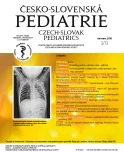Alternating antipyretic treatment of fever increases the risk of side effects
Authors:
D. Urbanová; D. Mikušíková; Ľ. Podracká
Authors‘ workplace:
Detská klinika LFUK a Národný ústav detských chorôb (NÚDCH), Bratislava
Published in:
Čes-slov Pediat 2018; 73 (3): 154-157.
Category:
Case Report
Overview
Fever is a non-specific response of the body characterized by an increase of core temperature above 38°C. It is responsible for 15–25% of consultations in primary care and therefore belongs to the most common health issues experienced by pediatric patients. Due to increasing anxiety about fever among parents it is necessary to emphasize the key importance of fever as a natural response of the immune system to bacterial or viral infection. Recent studies have concluded that relieving the patient’s discomfort should be the primary objective of antipyretic treatment rather than achieving normothermia. Non-steroid antiflogistic drugs are the medicine of first choice in fever therapy, however incorrect use and dosage can result in acute complications.
Key words:
fever, therapy, complications, ibuprofen, paracetamol, renal failure
Sources
1. Barbi E, Marzuillo P, Neri E, et al. Fever in children: Pearls and pitfalls. Children 2017; 4 (9): 81.
2. Richardson M, Purssell E. Who’s afraid of fever? Arch Dis Child 2015; 100: 818–820.
3. Harden LM, Kent S, Pittman QJ, et al. Fever and sickness behavior: Friend or foe? Brain Behav Immun 2015; 50: 322–333.
4. Parikh S, Saneto R, Falk MJ, et al. A Modern approach to the treatment of mitochondrial disease. Curr Treat Opt Neurol 2009; 11 (6): 414-430.
5. Sullivan JE, Farrar HC. Fever and antipyretic use in children. American Academy of Pediatrics, Section on Clinical Pharmacology and Therapeutics, Committee on Drugs. Pediatrics 2011; 127 (3): 580–587.
6. Javorka K, a kol. Lekárska fyziológia. Martin: Osveta, 2009: 361–366.
7. Balestracci A, Ezquer M, Elmo ME, et al. Ibuprofen-associated acute kidney injury in dehydrated children with acute gastroenteritis. Pediatr Nephrol 2015; 30: 1873–1878.
8. De Martino M, Chiarugi A, Boner A, et al. Working towards an appropriate use of ibuprofen in children: An Evidence-Based Appraisal. Drugs 2017; 77 (12): 1295–1311.
9. National Institute for Health and Clinical Excellence (NICE). Fever in under 5s: assessment and initial management 2013. https://www.nice.org.uk/guidance/cg160/chapter/1-Recommendations#antipyretic-interventions-2.
10. Chiappini E, et al. 2016 Update of the Italian Pediatric Society Guidelines for Management of Fever in Children. J Pediatr 2017; 1: 177–183.
11. Canadian Paediatric Society. Fever and temperature taking 2015. https://www.caringforkids.cps.ca/handouts/fever_and_temperature_taking.
12. Mulcahy D, et al. Infants and children: Acute management of fever. Clinical Practice Guidelines, NSW Department of Health 2010. http://www1.health.nsw.gov.au/pds/ActivePDSDocuments/PD2010_063.pdf.
13. Purssell E. Systematic review of studies comparing combined treatment with paracetamol and ibuprofen, with either drug alone. Arch Dis Child 2011; 96: 1175–1179.
14. Narayan K, Cooper S, Morphet J, Innes K. Effectiveness of paracetamol versus ibuprofen administration in febrile children: A systematic literature review. J Paediatr Child Health 2017; 53 (8): 800–807.
15. Wong T, et al. Combined and alternating paracetamol and ibuprofen therapy for febrile children. Evid Based Child Health. A Cochrane Rev J 2014; 9: 675–729.
16. Kelly M, Sahm LJ, Shiely F, et al. Parental knowledge, attitudes and beliefs on fever: a cross-sectional study in Ireland. BMJ Open 2017; 7 (7): e015684.
Labels
Neonatology Paediatrics General practitioner for children and adolescentsArticle was published in
Czech-Slovak Pediatrics

2018 Issue 3
Most read in this issue
- C3 glomerulopathy – a new clinical entity
- Current approach to asthma diagnosis and treatment in children
- News in cardiopulmonary resuscitation – „guidelines 2018“
- Macro AST – cause of asymptomatic aspartate aminotransferase elevation – case report
